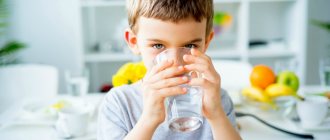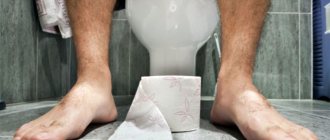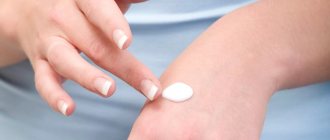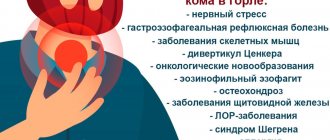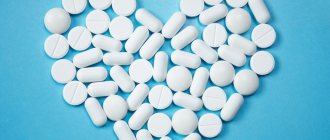What is acetone?
Acetonemic vomiting syndrome (acetone) in children, also known as ketotic hypoglycemia (CH) in childhood, is not a disease, but a metabolic disorder that can begin from 18 months to 5 years, and goes away by itself by 8-9 years of age. It is important to understand that during any illness, stress, or physical activity, the child must be given water, not limit sweets, and be given glucose in solutions and tablets.
With this disorder, the level of ketone bodies (this includes acetone) in the blood, urine and exhaled air increases, and the level of glucose in the blood decreases. The body tries to get rid of excess acetone and removes it through urine and exhaled air. This happens if a child goes hungry for a long time or the body consumes a lot of energy, then blood glucose drops and glycogen reserves are depleted. Since these ketone bodies are an alternative source of energy, when glucose levels are low, they begin to be produced in large quantities, which leads to intoxication of the body, and this, in turn, leads to nausea and vomiting. If normally ketones are detected only in trace amounts, then with this syndrome their amount increases by 50-80 times.
Why do children get acetone?
There is a mechanism for the occurrence of vomiting that is specific to childhood. Let's try to superficially explain its essence. So, the human body receives energy mainly from glucose. Glucose accumulates in the body, primarily in the liver, in the form of a special substance - glycogen. In adults, glycogen reserves are huge, in children they are insignificant. With physical exertion, emotional stress, high body temperature, i.e., with any phenomenon that requires significant energy expenditure from the child’s body, a situation may arise when glycogen reserves run out.
What we have as a result: there is no more glycogen, but energy is still very much needed. As a result, the body begins to receive energy from fat reserves. Intensive breakdown of fat is accompanied by the formation of acetone, which is excreted in the urine (i.e., acetone appears in the urine, which can be determined using special test strips). If there is a deficiency of fluid, acetone accumulates in the blood, irritating the mucous membranes of the gastrointestinal tract and the vomiting center in the brain. Vomiting and abdominal pain occurs. The described situation even received a special name - acetonemic state, and the vomiting that accompanies this condition is called, accordingly, acetonemic vomiting.
Whether a child develops an acetonemic state or not is determined by individual metabolic characteristics: glycogen reserves, the intensity of fat breakdown, and the ability of the kidneys to excrete acetone. Therefore, there are children in whom acetone never accumulates, even at a very high temperature and in a very serious condition, and there are those in whom an acetonemic state occurs in almost any illness - it’s just some kind of punishment.
Study of urinary ketone bodies
Ketone bodies can be detected using urine strip testing. You need to donate mid-stream morning urine, when the first portion of urine goes into the toilet, the middle part goes into a specially prepared sterile container, and the last part goes back into the toilet.
Urine analysis testing
Before collecting urine, you need to wash yourself. During the period leading up to the urinalysis, do not change your diet or do too much exercise.
A normal urine body test for ketones is negative. If ketone bodies are detected in the urine, treatment should be started immediately.
Symptoms
How to understand that a child has a tendency to an acetonemic state? After stress, physical and emotional stress, or during illness, the child develops the following signs:
- breath smells like acetone or rotten apples
- suddenly there was a pain in the stomach
- vomit
- weakness or even diarrhea
- the child constantly wants to sleep
This means the body needs glucose. The main thing is to give glucose and water in time, then vomiting can be avoided.
Application
Acetone is used as a raw material for the synthesis of many important chemical products, such as acetic anhydride, ketene, diacetone alcohol, mesityl oxide, methyl isobutyl ketone, methyl methacrylate, diphenylpropane, isophorone, bisphenol A and so on; example:
(CH3)2CO + 2C6H5OH ⟶ (CH3)2C(C6H4OH)2
The latter is widely used in the synthesis of polycarbonates, polyurethanes and epoxy resins.
Acetone is also a popular solvent. In particular, it is used as a solvent
- in the production of varnishes;
- in the production of explosives;
- in the production of medicines;
- in the composition of film adhesives as a solvent for cellulose acetate and celluloid;
- component for cleaning surfaces in various production processes;
- as a cleaner of tools and surfaces from polyurethane foam - in aerosol cans.
Without acetone, it is impossible to store acetylene in a compact (liquefied and in a cylinder) state, which is extremely explosive under pressure in its pure form. To do this, use containers with porous material soaked in acetone. 1 liter of acetone dissolves up to 250 liters of acetylene.
Acetone is also used in the extraction of many plant substances.
Acetone also serves as a raw material for the synthesis of acetic anhydride, ketene, diacetone alcohol and many other compounds.
Laboratory Application
In organic chemistry, acetone is used as a polar aprotic solvent, in particular in alkylation reactions
ArOH + RCl + K2CO3 ⟶ ArOR + KCl + KHCO3
for the oxidation of alcohols in the presence of aluminum alkoxides according to Oppenauer
RR′CH-OH + (CH3)2CO ⟶ RR′CO + (CH3)2CH-OH
Acetone is used to prepare cooling baths in a mixture with “dry ice” and liquid ammonia (cools to a temperature of −78 ° C).
In laboratories it is used for washing chemical glassware due to its low price, low toxicity, high volatility and easy solubility in water, as well as for quick drying of glassware and inorganic substances.
For laboratory purification, acetone is distilled in the presence of a small amount of potassium permanganate (until the solution turns slightly pink).
What to do?
Do not panic! Responsibility for the condition of the child lies only with you!
So, the child is nervous, hungry, and has a smell of acetone on his breath - give him a sweet drink, give him some sweets. Coca-Cola is best, because this drink has a lot of sugar and the child will drink it with great pleasure. This category also includes various sweet lemonades and sodas.
Do not put your child on a diet, especially a hungry one, especially one without sweets. This can make the situation worse. Don't limit your child's sweets! It is necessary to ensure that the distance between meals for the child is at least 4 hours.
It is also important to remember that stress in a state of acetonymia is contraindicated, just like a sharp increase in physical activity. You should always carry 40% glucose and candy with you.
If you doubt that your child has acetone, buy special test strips to determine it in urine. These are paper strips with a reagent that changes color depending on the acetone content in the urine.
If the child’s condition is more severe, then it is necessary to start giving him a sweet drink; in this case, saline solutions will only help against dehydration, but will not affect his well-being. But you can give a saline solution in parallel with sweets.
Sometimes it happens that if there is severe vomiting, it is impossible to give the child a sweet drink. In this case, glucose is administered intravenously or an injection of an antiemetic is given, and while it is working, this is about 2-3 hours, you need to let the child drink as much sweet liquid as possible.
If the condition does not improve, vomiting does not stop, and signs of dehydration appear, call an ambulance, as in this case infusion therapy is needed. As soon as the acetone crisis has passed, you just need to forget about it. Do not torment your child with diets, do not look for reasons, but simply live and do not forbid your child sweets, because in 100% of cases children outgrow this condition.
The main thing is to know how to provide first aid and not to scare the child with hospitalization. Of course, there are situations when a hospital cannot be avoided, for example, when intoxication and dehydration of the body are too severe, then the introduction of glucose through a vein is inevitable, but such conditions are very rare and most often we can cope at home ourselves.
It is worth remembering that this condition can develop in an absolutely healthy child, and acetone syndrome without other signs most often does not mean the presence of diabetes. But if acetone appears in a child often for no reason and is accompanied by sudden weight loss, the child often urinates and is constantly thirsty, then it is worth checking for type 1 diabetes.
Preparing a saline solution for dehydration
A treatment method aimed at introducing fluid into the body is called rehydration therapy. Rehydration is, in fact, the replenishment of fluid losses. There are two main methods of rehydration - intravenous, when the necessary solutions are injected into a vein through a dropper, and oral - when a person receives the necessary solutions through the mouth.
What it is? Sometimes it is a ready-made solution, but usually it is a powder, or tablet, or granules, which contain the sodium, potassium, chlorine and other substances necessary for the body in specially selected combinations and concentrations equivalent to pathological losses. Let me explain: sweating is a loss of not only fluid, but also sodium and chlorine (after all, sweat is salty, and everyone probably remembers the school formula NaCl). If you replenish fluid losses, but do not replenish salt losses, this is fraught with serious problems. How much salt do you still need? So smart scientists calculated the optimal amount of salts for a certain volume of water.
The formulas for rehydrating agents are based on these calculations. In addition to salts, the preparations often contain glucose; sometimes extracts of medicinal plants (chamomile extract, for example), and decoctions of cereals (rice, wheat, etc.) are added.
Oral rehydrating agents are an ideal option for quickly and effectively replenishing physiological and pathological fluid losses.
This is why oral rehydration products are over-the-counter medications.
That is why oral rehydration products should be an essential component of a home first aid kit.
Chemical properties
Acetone is one of the most reactive ketones.
Thus, it is one of the few ketones that forms a bisulfite compound: (CH3)2CO + NaHSO3 ⟶ (CH3)2C(OH)SO3Na
Under the influence of alkalis it enters into aldol self-condensation with the formation of diacetone alcohol:
2(CH3)2CO →OH− (CH3)2C(OH)CH2C(O)CH3
Reduced by zinc to pinacone:
2(CH3)2CO →Zn (CH3)2C(OH)C(OH)(CH3)2
Upon pyrolysis (700 °C) it forms ketene:
(CH3)2CO ⟶ CH2=C=O + CH4
Easily adds hydrogen cyanide to form acetone cyanohydrin:
(CH3)2CO + HCN ⟶ (CH3)2C(OH)CN
Hydrogen atoms in acetone are easily replaced by halogens. Under the influence of chlorine (iodine) in the presence of alkali, it forms chloroform (iodoform).
Hal2 + 2NaOH ⟶ NaHal + NaOHal + H2O
(CH3)2CO + 3NaOHal ⟶ CH3−CO−CHal3 + 3NaOH
CH3−CO−CHal3+NaOH ⟶ CHHal3↓ + CH3COONa
A qualitative reaction to dimethyl ketone is the presence of an intense red color with sodium nitroprusside in an alkaline environment. When CH3COOH is added, the color changes to red-violet.
(CH3)2CO + Na2[Fe(CN)5NO] + 2NaOH ⟶ Na4[Fe(CN)5ON=CHCOCH3] + 2H2O
Prevention
- To prevent CG, high-carbohydrate (bread, cereals, rice, pasta, corn tortillas) and high-protein foods (red meat, chicken and turkey, fish, beans, eggs, nuts) are recommended. Do not allow your child to take long breaks from eating (maximum 6 hours); It is advisable that the child has at least 5 meals a day. A snack before bed is a must (milk, bun, cereal, bananas)!
- In case of an acute infectious disease, fever, nausea, vomiting, or loss of appetite, you should immediately begin giving the child sweet drinks (juices, lemonades, sweet tea, Coca-Cola). It is not necessary and useless to try to feed a child with CG only Borjomi/Narzan/Essentuki/saline solutions: they can prevent dehydration, but without sweet drinks it will not be possible to get the child out of CG, so saline solutions are only an additional measure to sweet drinks.
- If you are constantly vomiting and cannot replace fluid loss at home, you should immediately seek help from a doctor. Only if home drinking does not produce an effect, you should drip solutions intravenously - this method of treatment should not be used as a basic one.
What exactly CG is not:
- CH is not a disease, but only a violation of the tolerance to prolonged fasting
- CG is not a “neuroarthritic diathesis” (there is no such disease). CG is a real problem, “neuro-arthritic diathesis” is a mythical animal, therefore, these two things are not related. What does not exist should not be treated.
- CG does not lead to diabetes and is in no way associated with it.
- CH is not and never has been a “disorder of purine metabolism.” If someone claims the opposite, he does not understand either the metabolism of purines, or the metabolism of carbohydrates, or metabolism in general. CG is not a disorder of uric acid metabolism and is not associated with gout. A restrictive diet is not indicated, it is dangerous and harmful for CG, and people who recommend that children with CG avoid meat and carbohydrates have absolutely no understanding of this condition.
- “Gall bladder bend” is a variant of the normal structure of the gallbladder, and it is very common; this feature is in no way related to CG. By the way, if you have an excess of gallstones, you don’t need a diet either.
- KG is not a kidney disease.
- CG is not a liver disease.
So, the acetonemic state/ketotic hypoglycemia is not a disease, but a metabolic feature that requires the parent not to torment the child with diets and endless searches for the cause, but attention, so as not to miss and prevent the onset of a crisis. Timely drinking and a “sweet diet” will allow the child to safely outgrow this condition.
Receipt
World production of acetone is more than 6.9 million tons per year (as of 2012) and is growing steadily.
In industry it is obtained directly or indirectly from propene.
Cumene method
The main part of acetone is obtained as a co-product in the production of phenol from benzene using the cumene method. The process takes place in 3 stages.
In the first stage, benzene is alkylated with propene to produce cumene; in the second and third (Udris-Sergeev reaction), the resulting cumene is oxidized by atmospheric oxygen to hydroperoxide, which, under the action of sulfuric acid, decomposes into phenol and acetone:
C6H6 + CH3CH=CH2 ⟶ C6H5CH(CH3)2 C6H5CH(CH3)2 + O2 ⟶ C6H5C(OOH)(CH3)2 C6H5C(OOH)(CH3)2 ⟶ C6H5OH + (CH3)2CO From isopropanol
According to this method, isopropanol is oxidized in the vapor phase at temperatures of 450–650 °C on a catalyst (metallic copper, silver, nickel, platinum). Acetone with high yield (up to 90%) is obtained on a “silver on pumice” catalyst or on a silver mesh:
(CH3)2CH-OH + O2 ⟶ (CH3)2CO + H2O2 Propene oxidation method
Acetone is also obtained by direct oxidation of propene in the liquid phase in the presence of PdCl2 in solutions of Pd, Cu, Fe salts at a temperature of 50-120 °C and a pressure of 50-100 atm:
CH3CH=CH2 + PdCl2 + H2O ⟶ (CH3)2CO + Pd + 2HCl 2Pd + 4HCl + O2 ⟶ 2PdCl2 + 2H2O
The method of fermentation of starch under the action of bacteria Clostridium acetobutylicum with the formation of acetone and butanol is of some importance. The method is characterized by low yields. Methods of production from isopropyl alcohol and acetylene are also used.
Dietary recommendations
Products that are strictly excluded from the diet of children suffering from acetone syndrome:
- kiwi;
- caviar;
- sour cream - any;
- sorrel and spinach;
- young veal;
- offal - lard, kidneys, brains, lungs, liver;
- meat - duck, pork, lamb;
- rich broths - meat and mushroom;
- vegetables - green beans, green peas, broccoli, cauliflower, dry legumes;
- smoked dishes and sausages
- You will have to give up cocoa and chocolate in bars and drinks.
The diet menu must include: rice porridge, vegetable soups, mashed potatoes. If symptoms have not returned within a week, you can gradually add dietary meat (not fried), crackers, herbs and vegetables.
The diet can always be adjusted if signs of the syndrome return again. If you have bad breath, you need to add a lot of water, which you need to drink in small portions.
- On the first day of the diet, you should not give your child anything other than rye bread crackers.
- On the second day, you can add rice water or dietary baked apples.
- If you do everything correctly, then by the third day the nausea and diarrhea will go away.
Under no circumstances should you stop the diet if your symptoms go away. Doctors recommend strictly adhering to all its rules. On the seventh day, you can add biscuits, rice porridge (without oil), and vegetable soup to your diet. If the body temperature does not rise and the smell of acetone has disappeared, then the baby’s diet can be made more varied. You can add lean fish, vegetable puree, buckwheat, and fermented milk products.
How to treat acetone syndrome
If an acetonemic crisis develops, the child must be hospitalized. Dietary correction is carried out: it is recommended to consume easily digestible carbohydrates, strictly limit fatty foods, and provide frequent drinking in large quantities. A good effect is obtained from a cleansing enema with sodium bicarbonate, a solution of which can neutralize some of the ketone bodies that enter the intestines. Oral rehydration using combined solutions (Orsol, Rehydron, etc.), as well as alkaline mineral water, is indicated.
The main directions of treatment of non-diabetic ketoacidosis in children:
1) A diet (enriched in fluids and readily available carbohydrates with limited fat) is prescribed to all patients.
2) The administration of prokinetics (motilium, metoclopramide), enzymes and cofactors of carbohydrate metabolism (thiamine, cocarboxylase, pyridoxine) promotes an earlier restoration of food tolerance and normalization of fat and carbohydrate metabolism.
3) Infusion therapy:
- quickly eliminates dehydration (deficiency of extracellular fluid), improves perfusion and microcirculation;
- contains alkalizing agents, accelerates the restoration of plasma bicarbonate levels (normalizes acid-base balance);
- contains a sufficient amount of easily accessible carbohydrates, which are metabolized in various ways, including those independent of insulin;
4) Etiotropic therapy (antibiotics and antiviral drugs) is prescribed according to indications.
In cases of moderate ketosis (acetonuria up to ++), not accompanied by significant dehydration, water-electrolyte disturbances and uncontrollable vomiting, diet therapy and oral rehydration are indicated in combination with the prescription of prokinetics in age-related doses and etiotropic therapy of the underlying disease.
When treating acetone syndrome, the main methods are those aimed at combating crises. Supportive treatment is very important to help reduce exacerbations.
Detection
In chemical-toxicological analysis, reactions with solutions of iodine, sodium nitroprusside, furfural, ο
-nitrobenzaldehyde and microdiffusion method.
Reaction to iodoform formation
.
When acetone reacts with iodine solution in an alkaline medium, triiodomethane (iodoform) is formed:
I2 + 2OH− ⟶ IO− + I− + H2O 3IO− + CH3COCH3 ⟶ I3C-CO-CH3 + 3OH− I3C-CO-CH3 + OH− ⟶ CHI3 + CH3COO−
To 1 ml of the test solution add 1 ml of a 10% ammonia solution and a few drops of a solution of iodine in potassium iodide (iodine tincture). In the presence of iodine, a yellow precipitate of triiodomethane with a characteristic odor is formed, and its crystals have a characteristic hexalray shape. The detection limit is 0.1 mg of acetone in the sample.
Reaction with sodium nitroprusside (Legal's test)
.
Acetone with sodium nitroprusside in an alkaline medium gives an intense red color. When acidified with acetic acid, the color turns red-violet. Ketones, whose molecules lack methyl groups directly bonded to ketone (CO—) groups, do not give such a reaction. Accordingly, ketones such as methyl ethyl ketone, methyl propyl ketone and others will also give a red color with nitroprusside.
CH3COCH3 + Na2[Fe(CN)5NO] + 2NaOH ⟶ Na4[Fe(CN)5ON=CHCOCH3] + 2H2O
To 1 ml of the test solution add 1 ml of a 10% sodium hydroxide solution and 5 drops of a 1% freshly prepared sodium nitroprusside solution. In the presence of acetone, a red or orange-red color appears in the sample. When a 10% solution of acetic acid is added to an acidic reaction, after a few minutes the color turns red-violet or cherry-red. It should be noted that butanone gives a similar color to sodium nitroprusside.

